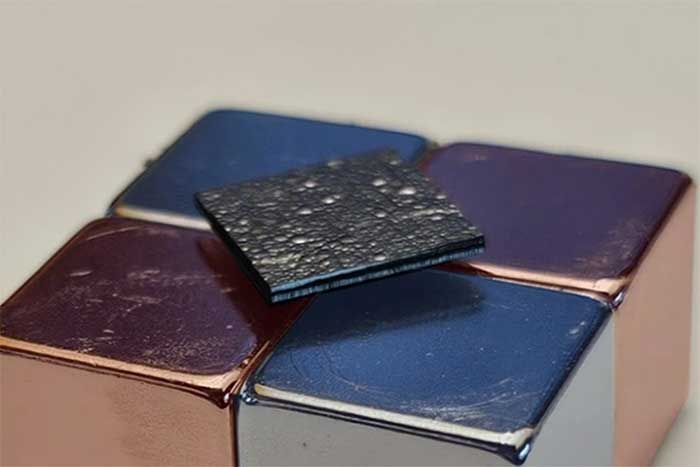The boundaries in materials science and sensor technology are being broken by a study that combines levitation forces, thermal insulation capabilities, and real-time feedback.
Researchers at the Quantum Machine Unit of the Okinawa Institute of Science and Technology (OIST) have made a breakthrough with a graphite material, allowing it to levitate in a stable position without any physical contact or mechanical support.

The graphite plate levitating on a magnetic support. (Photo: OIST).
Typically, we are familiar with this type of experiment using metallic (iron) materials or magnets. However, graphite also exhibits diamagnetic properties, meaning it interacts with magnetic fields.
Based on this fact, the scientists coated a small square of graphite particles with silica. They then used wax to convert the material into an insulating substance, helping it resist rapid energy loss from the magnetic support.
As a result, the researchers created a thin square plate of a few centimeters made of graphite, capable of levitating above magnets arranged in a grid pattern.
Professor Jason Twamley, the head of the research team, emphasized that this system can operate efficiently without relying on external power sources. Moreover, it creates a favorable environment to support the development of ultra-sensitive sensors for effective and precise measurement.
Professor Jason explained that when an external magnetic field acts on “diamagnetic” materials, they generate a counteracting magnetic field, known as repulsive force, which helps push the material away from the magnetic field.

Maglev train utilizing diamagnetic material technology, enabling the train to move without touching the track. (Photo: Getty).
Therefore, objects made of diamagnetic materials can levitate over strong magnetic fields. For example, in maglev trains, superconducting magnets create a strong enough magnetic field to lift diamagnetic materials. Ultimately, the train can even move without touching the track, creating an effect that challenges gravity.
However, creating a “levitating” system without an external power source still faces several challenges. The biggest limiting factor is the issue of “eddy-current damping”, which occurs when an oscillating system loses energy over time due to external forces.
This energy loss has hindered the use of magnetic repulsion to develop advanced sensors.
Additionally, another issue is the reduction of kinetic energy of the entire system. Typically, to achieve a “frictionless”, self-sustaining platform, we need to address both the challenges of eddy-current damping and kinetic energy.
To tackle these issues, the research team focused on creating a new type of material derived from graphite. By chemically modifying it, they successfully transformed graphite into an insulating material.
This modification prevents energy loss while allowing the material to levitate and hover in a vacuum under laboratory conditions.
“If continuously cooled, our platform could outperform even the most sensitive atomic gravimeters developed to date,” Professor Jason shared.
“Our ongoing work focuses on improving this system to completely isolate it from external disturbances such as vibrations, magnetic fields, and electrical noise.”
By combining levitation forces, thermal insulation capabilities, and real-time feedback, Professor Jason’s team is pushing the boundaries of what is achievable in materials science and sensor technology.
This research also opens up exciting possibilities for ultra-sensitive sensors, enabling them to achieve precise control on similar oscillating platforms.


















































